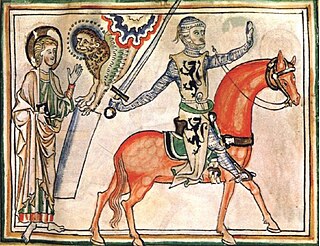
Sir William Wallace was a Scottish knight who became one of the main leaders during the First War of Scottish Independence.

The Wars of Scottish Independence were a series of military campaigns fought between the Kingdom of Scotland and the Kingdom of England in the late 13th and early 14th centuries.
There have been at least eight sieges of Stirling Castle, a strategically important fortification in Stirling, Scotland. Stirling is located at the crossing of the River Forth, making it a key location for access to the north of Scotland.
Andrew Moray, also known as Andrew de Moray, Andrew of Moray, or Andrew Murray, was an esquire, who became one of Scotland's war-leaders during the First Scottish War of Independence. He initially raised a small band of supporters at Avoch Castle in early summer 1297 to fight against the rule of King Edward I of England, and soon had successfully regained control of north Scotland for King John Balliol. He subsequently merged his army with that of William Wallace, and jointly-led the combined army to victory at the Battle of Stirling Bridge on 11 September 1297. Moray was mortally wounded in the fighting at Stirling, dying at an unknown date and place that year.

Guy of Dampierre was the Count of Flanders (1251–1305) and Marquis of Namur (1268–1297). He was a prisoner of the French when his Flemings defeated the latter at the Battle of the Golden Spurs in 1302.

The First War of Scottish Independence was the first of a series of wars between English and Scottish forces. It lasted from the English invasion of Scotland in 1296 until the de jure restoration of Scottish independence with the Treaty of Edinburgh–Northampton in 1328. De facto independence was established in 1314 at the Battle of Bannockburn. The wars were caused by English kings attempting to establish their authority over Scotland while Scots fought to keep English rule and authority out of Scotland.
Robert de Brus, 6th Lord of Annandale, jure uxoris Earl of Carrick (1252–1292), Lord of Hartness, Writtle and Hatfield Broad Oak, was a cross-border lord, and participant of the Second Barons' War, Ninth Crusade, Welsh Wars, and First War of Scottish Independence, as well as father to the future king of Scotland Robert the Bruce.

Sir Simon Fraser of Oliver and Neidpath was a Scottish knight who fought in the Wars of Scottish Independence, for which he was hanged, drawn, and quartered in 1306.
Events from the 1300s in England.

Henry de Percy, 1st Baron Percy of Alnwick was a medieval English magnate.

Sir John Menteith of Ruskie and Knapdale was a Scottish nobleman during the Wars of Scottish Independence. He is known for his capture of Sir William Wallace in 1305 and later joined with King Robert I of Scotland and received large land grants in Knapdale and Kintyre for his service. He is described as "guardian" of the Earldom of Menteith, as his great-nephew Alan II, Earl of Menteith was a minor at the time of the death of Alan I, Earl of Menteith.

Sir William FitzWarin was an English soldier active during the First War of Scottish Independence. He was the constable of Urquhart Castle (1296-1297) and after the English defeat at the Battle of Stirling Bridge on 11 September 1297, he was appointed constable of Stirling Castle, which he later surrendered and was imprisoned in Dumbarton Castle.

Walter de Huntercombe, 1st Baron Huntercombe (1247–1313) was an English military commander during the Wars of Scottish Independence and a Governor of Edinburgh Castle.
Alexander Pilche was a 13th-century Scottish burgess. He joined with Andrew de Moray during the 1297 uprising in northern Scotland against the administration and overlordship of King Edward I of England. He was the Governor of Inverness Castle on behalf of the English in 1304. before being replaced in 1305 and joining King Robert I of Scotland's campaign in Moray in 1307. As a reward he was appointed Sheriff of Inverness until his death.

Sir William de Monte Alto of Ferne, also known as William de Mohaut (d.1327) was a 13th-14th century Scottish noble.
Sir Walter de Berkley 8th of Gartly was a 13th-14th century Scottish noble.

Sir Henry St Clair was a 13th-14th century Scottish noble, who was the 7th Baron of Roslin and Lord of Catcune.
Sir Edmund Comyn of Kilbride was a 13th-14th century Scottish noble. He was a younger son of William Comyn of Kilbride and Euphemia de Clavering.
Upsettington Castle was a castle that was located near Upsettington, Scottish Borders, Scotland. The castle was the caput baronium of the Lordship of Upsettlington. The lands and barony was granted to the Bisset family by King William I of Scotland. Upsettlington was strategically located adjacent to the English Norham Castle across the River Tweed. The castle was sacked and destroyed in 1297–1298, while William Bisset, Lord of Upsettlington was in Flanders serving in King Edward I of England's expedition to Flanders.

William de Moravia, was a Scottish nobleman, 2nd Earl of Sutherland and chief of the Clan Sutherland, a Scottish clan of the Scottish Highlands.
This page is based on this
Wikipedia article Text is available under the
CC BY-SA 4.0 license; additional terms may apply.
Images, videos and audio are available under their respective licenses.












